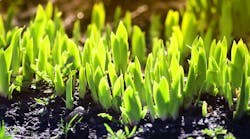Holding true to its pursuit of horticultural lighting as a business growth driver, Signify has announced a couple of installations at tomato farms where yields have either already increased substantially or where the hope is that they will, via the use of the company’s LED toplights in one instance, and in the other, with a combination of LED interlights and HPS toplights.
Like many of its recent deployments, the latest are in northern climates, this time in Norway and in Russia. The lighting enables year-round production in these colder territories.
Signify CEO Eric Rondolat has positioned horticulture as one of the firm’s key planetary “sustainability” sectors, noting that improvements in plant-growth technology will help address the challenge of feeding a growing population.
Norwegian nursery and Signify user Miljøgartneriet pointed out the additional environmental benefit that locally grown crops cut down on harmful CO2 emissions entailed in shipping produce from warmer countries further south.
“Many supermarket chains want to be able to offer their customers fresh and tasty fruits and vegetables with a significantly lower carbon footprint than those that come from Southern Europe,” said Miljøgartneriet CEO Kåre Wiig. “This is something we can provide all year, thanks to our cooperation with Signify.”
In what is expected to be the first stage of a larger project, Miljøgartneriet installed Signify’s Philips GreenPower LED toplights over 1 hectare of tomatoes and 0.4 hectares of peppers at its 7-hectare (70,000m2 — about 753,000-ft2) greenhouse facility in Naerbø, Rogaland, Norway. It also installed Signify’s GrowWise control system to vary brightness levels — for instance, to dim or turn off the lights on sunny days. The spectrum appears to be preset.
Signify did not reveal any yield increase attributable to the lights, which went in before the last growing season. Miljøgartneriet was beginning to harvest and deliver the produce locally earlier this month.
Meanwhile, in Russia, Signify said tomato yields increased 18% over a year, and 24% from November to early March, in a two-year, 1-hectare pilot at the 80-hectare Agrokultura Group greenhouses near Moscow. Agrokultura uses Signify’s traditional high-pressure sodium (HPS) toplighting across all 80 hectares, and has been trialing Signify LED interlights on one of those hectares.
Interlighting is placed within the plants rather than high above, and thus brings light closer to the crop — a benefit, considering that in a greenhouse, approximately a third of sunlight does not reach that area, according to Signify.
But conventional HPS could emit heat that would damage the plant. Energy-efficient LEDs, which run cooler, minimize that risk and thus can be used to more directly apply spectrally-tuned light.
In another recent interlighting job, Signify provided the technology to Canadian cucumber grower Albuna Farms in Kingsville, Ontario.
Many of Signify’s greenhouse projects have been in northern countries, such as Albuna and another that LEDs Magazine reported on recently in British Columbia, where Canadian Valley Growers is using LED toplights for lettuce growth.
Editor’s note: LEDs Magazine will again hold its HortiCann Light + Tech Conference virtually in 2021, this time from Sept. 28–29. Register to join us and learn from speakers with vital information on horticultural science, AgTech systems, and business use-case success stories.
MARK HALPER is a contributing editor for LEDs Magazine, and an energy, technology, and business journalist ([email protected]om).
For up-to-the-minute LED and SSL updates, why not follow us on Twitter? You’ll find curated content and commentary, as well as information on industry events, webcasts, and surveys on our LinkedIn Company Page and our Facebook page.






